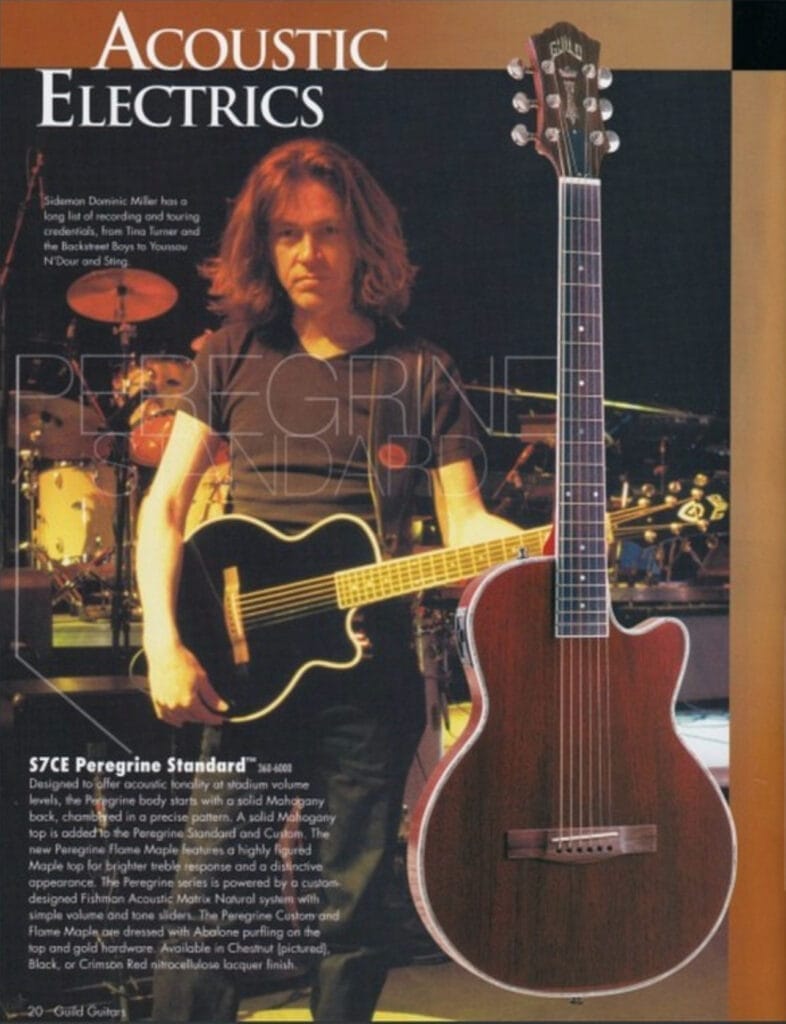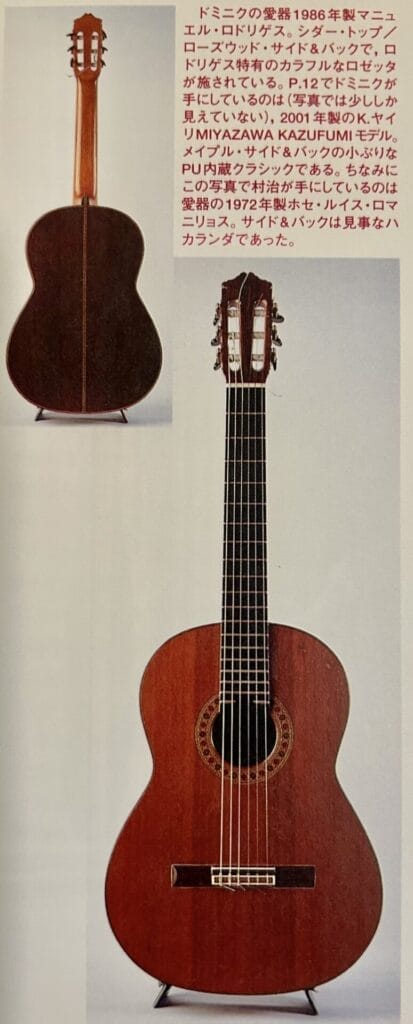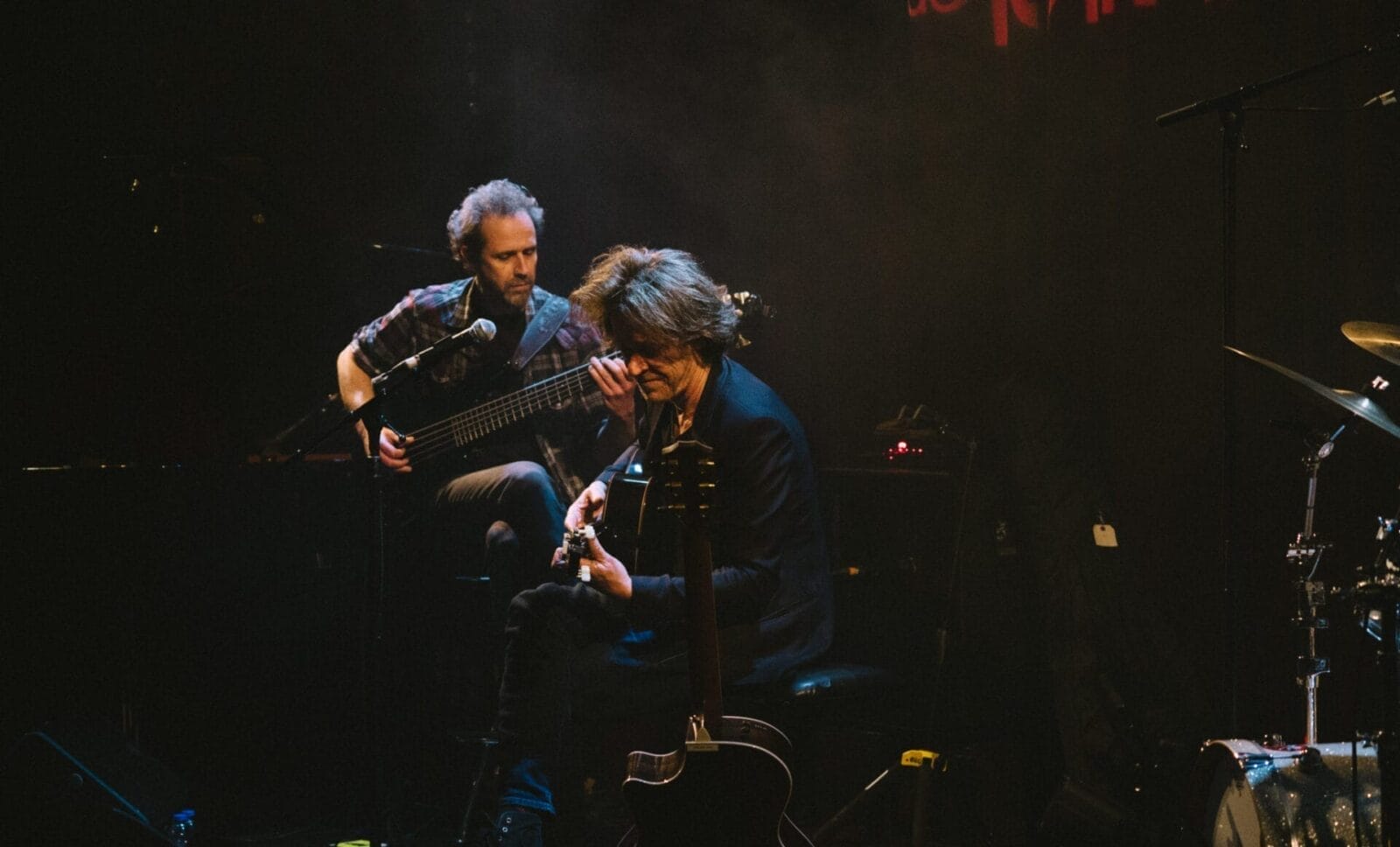■ K.YAIRI CYTM ■
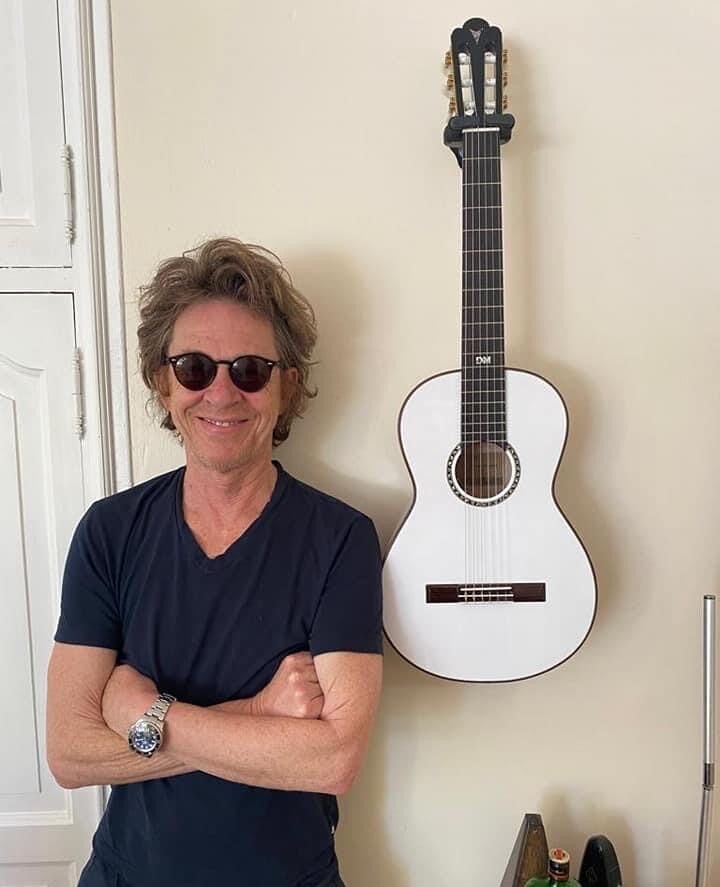
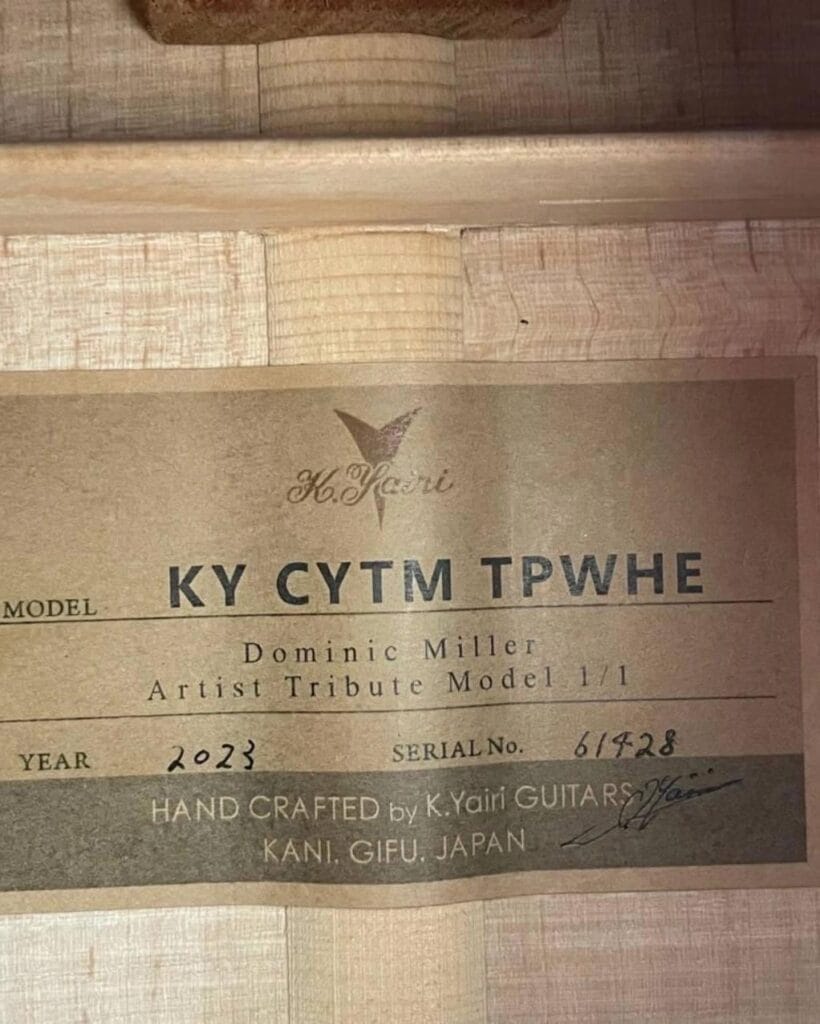

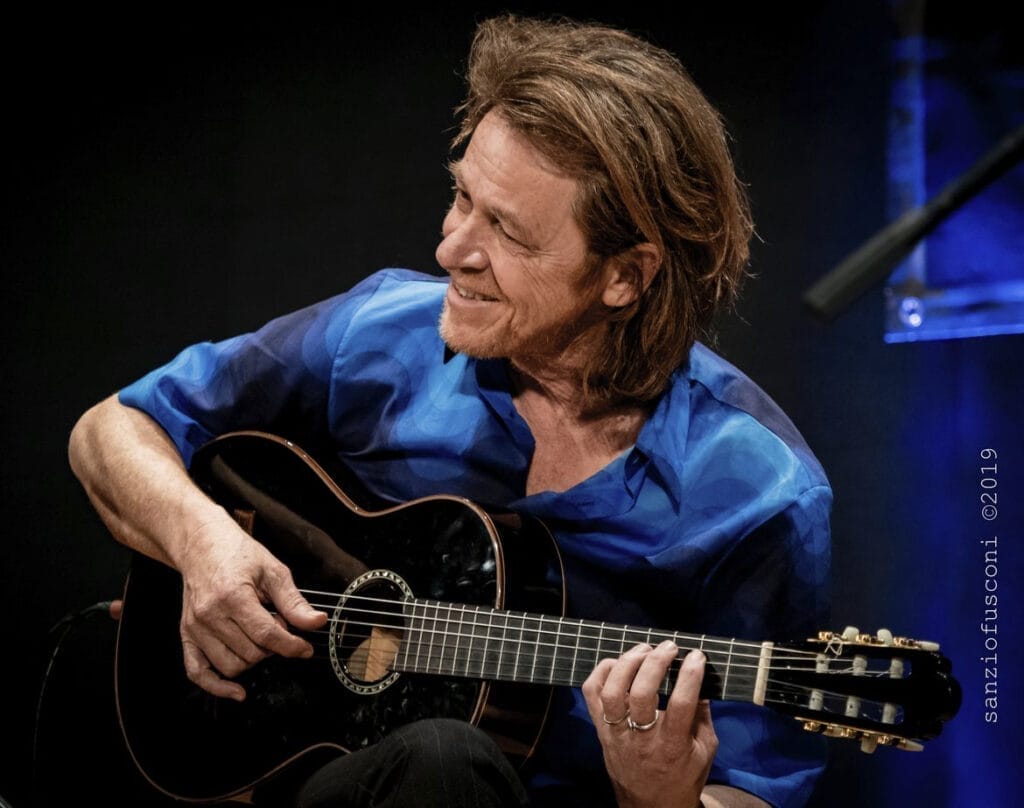
■ Commentary ■
Encounter with K.Yairi Guitars
This Japanese K. Yairi guitar is completely Dominic’s main guitar.
I think Dominic now has five or six Yairi guitars of the same type. He liked it so much that he gave the same one to Sting. Sting uses it a lot on his album “The Bridge”.
Dominic’s first encounter with this guitar was when Kazufumi Miyazawa of The BOOM (Japanese band) gave it to him when he came to Japan on tour with Sting in 2004. Dominic participated fully in Miyazawa’s solo album ”Sixteenthmoon” (1998) and has been friends with him ever since.
So for a while after Dominic got this guitar, he called it ‘Kazafumi’. He probably got Miyazawa’s name a little bit wrong.
And he said, “I am addicted to this instrument and can’t seem to put it down.”
The first model given to him by Mr Miyazawa was a natural finish, numbered ‘001’ for Mr Miyazawa and ‘002’ for Dominic. However, he liked it so much that he immediately ordered a black model of the same type. This was ‘003’ and he gave the same one to Sting, so Sting has ‘004’.
Dominic mainly uses the natural painted model on recordings, and until recently he always used the black model gigs, which only differs in colour. The reason for this, he says, is that “the black one is cooler, it’s more rock ‘n’ roll!” He says.
The white guitar in the photo above is his latest acquisition. It’s basically the same specs as the first model he got. Or rather, Dominic seems to have asked for it and ordered it: “The specs I’ve had so far are the best, so don’t change them!” But always the same is boring, so this time Yairi suggested, “Why don’t you change the colour?” So he took the plunge and asked for white. Dominic calls this guitar ‘Grace’. It is indeed a beautiful guitar with a touch of elegance.
And if you look closely, you will see that this guitar is different from the previous ones, as the initials ‘DM’ seem to be embedded in the frets with white butterfly shells or something. This gives the guitar an extra ‘class’ feel. Also, I think he probably calls the natural one ‘Blondy’.
Dominic’s favourite thing about this Yairi guitar is that “the overtones are just amazing!“.
It seems that Dominic really loves these guitars from this Japanese workshop and he often talks about how great they are in interviews abroad. For example, in an interview in Germany he said.
”Japanese yairi guitars are great because they are made from carefully selected old wood. My yairi is made from maple that has been aged for years before being carved. I firmly believe that the way the wood is cut has a huge effect on the sound of the guitar. And the Japanese are better than anyone at cutting wood into smaller pieces for their guitars.”
As a Japanese, I am very happy that a very sound-oriented musician like Dominic likes Japanese instruments so much.
Well, the Japanese are probably the best in the world at working with wood, not just guitars. We’ve been using wood for everything in our lives for thousands of years. Depending on the purpose and situation, we skilfully change the way we work with wood.
In addition, basically the quality of handmade products is extremely high, as many Japanese people are very skilled with their hands. Even for standardised products, the level of quality required is generally high, and the company prides itself on not releasing products to the outside world that do not meet these standards.
This is why Dominic often recommends YAMAHA guitars to people just starting out. There may not be any outstanding features, but the price is affordable and the quality is very consistent.
Details about this guitar
Details about this Yairi guitar.
First of all, the background of the guitar manufacturer Yairi is that it started in 1935 as Yairi Instrument Manufacturing, initially producing various wooden instruments including guitars, but in 1965 it began full-scale guitar production as Yairi Guitar. Yairi guitars are characterised by meticulous craftsmanship that spares no time or effort, original design with unique ideas, good quality wood and sufficient natural drying, high playability and a very reasonable price for an instrument of this standard.
The black model that Dominic has been using live for a long time is a made-to-order model from 2010. Originally there was no model name because it was made to order, but this guitar is very popular overseas and is still sold in Europe under the name CYTM E through Yairi-Europe. Unfortunately, the corresponding model is not listed on the Japanese website, and the guitar is not available in Japan unless ordered as a complete custom line.
The part number ‘CYTM’ represents the specifications C (Classic), Y (Yairi), T (Torres type) and M (Maple body). The part after that, for example ‘E’, represents the electrical specification. It is a little unclear what the letters ‘TPWHE’ mean in this photo.
This model is essentially built as a classical guitar. As you can see in the picture, the body size is considerably smaller than a normal guitar in relation to the scale. It is based on an 18th century classical guitar called the Torres model. While a typical classic has a body width of around 390mm, the ‘CYTM E’ is 327mm, even smaller than Martin’s smaller Single 0 model (343mm).
Dominic says that this guitar has a great overtone sound but, reading the comments on K.Yairi’s website from the craftsman who makes this smaller type of guitar, he says: “It is very difficult to harmonise the sound and design because of its small size compared to a normal classical guitar.” This means that they must have taken a lot of care in making their guitars.
There are several variations of the Yairi Torres type, with Dominic’s being the most compact model. So this guitar is quite ‘light’. Another reason for this lightness is that Yairi uses nikawashi gluing, according to the May 2019 issue of the Japanese magazine Player, although I don’t know the details.
The body top is made of Sitka spruce and the side and backs are made of Maple. It’s also hard to tell from the photos, but the black guitar has maple grain visible under the finish.It must look very beautiful!
The scale is 640 mm, about 10 mm shorter than modern classical guitars.The nut width is 50mm.
The electric model features a Fishman Matrix Infinity pickup and preamp system. This is a popular Fishman model and the control is located inside the soundhole, so it not only produces a realistic and natural nylon-string sound, but also does not detract from the guitar’s appearance.
In fact, it seems that Dominic has other Yairi guitars besides this ‘CYTM’. In March 2023, when Dominic came to Japan on tour with Sting, he was interviewed by the Japanese ‘Acoustic Guitar Magazine’ issue 96. The guitar he brought with him was a 2010 RUG-65 Custom. The material is the same as the ‘CYTM’. The scale is 609 mm.
At the beginning of November Dominic will be playing some gigs in Germany and I’m sure the white ‘Grace’ will be used.


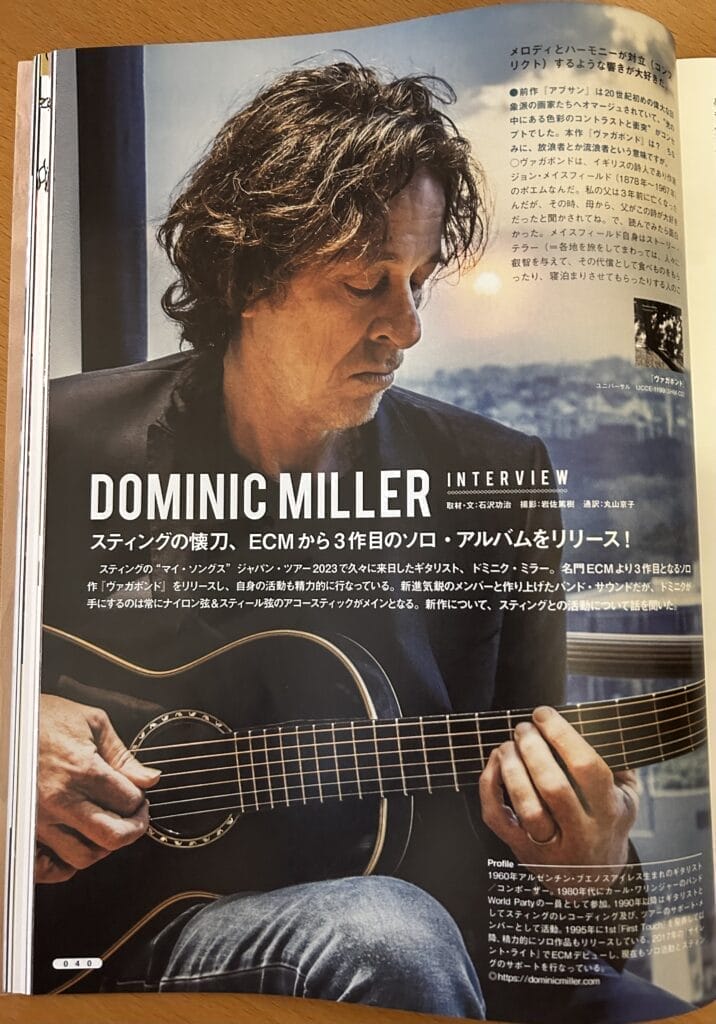

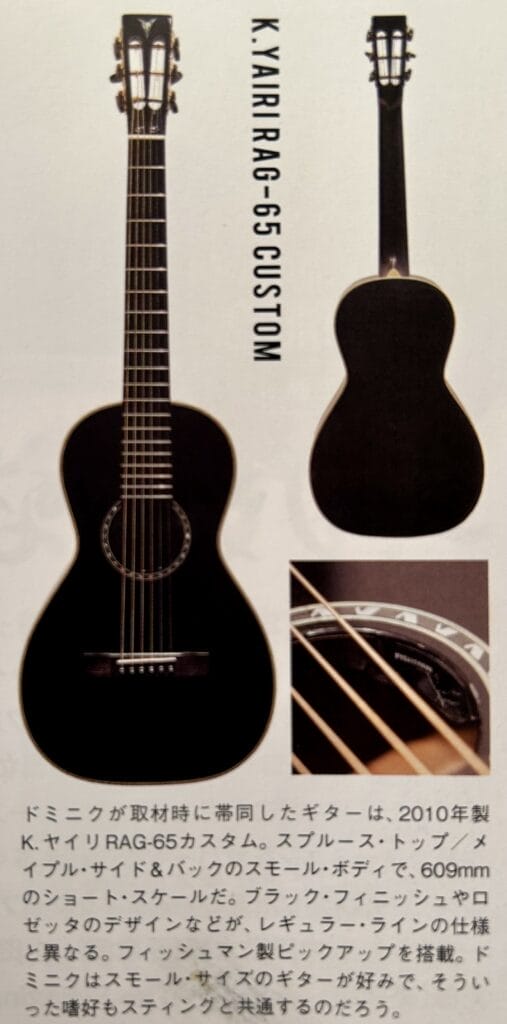

※P.S. This article was written with reference to the May 2019 issue of Player and issue 96 of Acoustic Guitar Magazine.
11.26.2023追記 (11.30.2023 Postscript)
このK.Yairiのギターはドミニクがメインのギターとして長年愛用している為、日本だけでなく世界中で「ドミニクと同じギターが欲しい」と注文をしている人が居るようです。そのため、このサイトが公開になってから、この記事に関して私のところにいくつかの質問や、逆に新しい情報が様々な人から寄せられましたので、まとめて追記と回答をしたいと思います。
【寄せられた情報】
- ドミニクが住むフランスのK-Yairiでは、この「CYTM」をオーダーする事ができますが、ドミニクが持っているモデルと違うのは、ドミニクのものにはネックサイドにポジションマークがありますが、フランスの「CYTM」の標準仕様には無い、とのことです。
- このトーレスタイプのボディの部分を開発したのは、K-Yairiに昔いたクラフトマンの小川さんという、アーティスト担当の方だったようです。しかしもうその方はK-Yairiを退職され、別のギターの販売会社を立ち上げているそうです。その会社(Vincent)ではギターの製作はしていません。
- 日本では、このドミニクモデル「CYTM」(厳密に言うと宮沢和史モデル)はカスタムラインでオーダーする事になりますが、トップ材はシトカスプルースで統一です。(これも木目が均一に揃う素晴らしいものです)。しかしサイドとバックのフレイムメイプル材は2つのランクがあります。1つは通常のもので、もう一つは厳選されたフレイムメイプル材。当然ドミニクのギターは厳選されたメイプル材のタイプになりますが、そちらを選ぶと価格は上がることになります。
- どうやらドミニクはこの白の【Grace】と同時に黒のものもオーダーしていたようで、同時に納品されたようです。
- K.Yairiでは「CY-TM / CY-TME」のモデルに関しては、基本的にドミニクとカラーやインレイ(はめ込み)以外同じ仕様でオーダー可能だそうです。しかし、上の写真にもありますが、ドミニクミラー仕様の「KY CYTM TPWHE DominicMiller Artist Tribute Model」と同じもののオーダーは残念ながら不可だそうです。これはドミニクのためだけのギターという事ですね。
【頂いた質問への返答】
【それ以外の補足説明】
- 弦に関しては、ドミニクは普通のクラシックギターにはオーガスティン・ブルーのセットを勧めています。また、スティングのライブで使っているエレアコのAcoustic-Electric GuitarのGuild Palomaや、同じくGuild のPeregrineには、やはりダダリオのエクストラハードテンションを勧めています。
- ドミニクはこのK.Yairiのギターを2004年に宮沢さんにプレゼントされた後の2006年リリース、「The Fourth Wall」ではほとんどこのギターで演奏しています。
- ドミニクは弦を頻繁に張り替えません。これはDiscograpyの「Heartbeat」のところでも書いていますが、少し錆が浮いているくらいの方が、自分の好みの「少しスモーキーな音になる」という理由からです。はっきりとした張り替え時期はよくわからないんですが、3ヶ月くらいは同じものを使うことが多いようです。3ヶ月でもまだ新しい部類かもしれないとも言っています。
ナイロン弦は張ったばかりの頃はいい音だけど3~4ヶ月くらい経つとひどい音になるが、それを過ぎると味のある良い音になる、と彼は言っていました。切れるまで替えない、みたいなことを言ってた事もあります。しかし、弦のイントネーションがなくなったら交換時期だそうです。
ちなみにエレキギターはフェンダーのカスタムメイドのものを、ライブのたびに毎回張り替えています。 - いい音で演奏するにはやはり背中や腰をまっすぐに、肩に余計な力を入れない事が大切です。
- エフェクターに関してはアコギでかけるのはリバーブだけです。コンプレッション系は絶対にかけません。でもなんと言っても「一番のエフェクトは指での表現だ」と言っています。これは成果を出すまでに時間がかかるけど、その価値はある、と言っています。
- レコーディングに関してはマイクのみの使用です。これはECMのレコーディングのプライドであり、絶対に譲れない部分です。また、ドミニクがマイクの位置などに自分から注文をつけることはありません。それは彼らの方がその部分はプロフェッショナルであり、自分がやるべき事は「良い音を出す事」だという考えです。あとはそういった妙な「自分のこだわり」を押し通すことは、現場のチームワークを乱すだけで良い事にはならないと彼は良くわかっているからです。
- 演奏時のフィンガーノイズ防止のため、ドミニクは演奏前には「手を洗わない」ようです。指から出る自然な汗や一般的な汚れは最高の鳴き止めになるから手を洗うのは演奏後だ、と言っています。
- クラシックギターにピックアップを付ける場合はブリッジにアクティブ・ピックアップをつけてください、とのことです。
- もしギターを飛行機に預けるときは弦を必ず緩めてください、とのことです。飛行機の貨物室の中では気温が零下になることもあるからです。
- お気づきの人も多いでしょうが、ドミニクのギターの構え方は少し独特です。通常のクラシックギターの構え方とは異なり、右足の方にギターを乗せたフラメンコの演奏スタイルに近い構え方です。また、ネックはほぼ床に水平にしています。コレに関しては音楽学校で先生に直すように目をつけられたようですが、「自分のベストな弾きやすい方法はこれだ」と譲らなかったそうです。
- ドミニクは1年間に10本ほどしか生産されないスペインのコルドバの工房で作られた1986年製のマニュエル・ロドリゲスのクラシックギターを持っています。
アルバム「Shapes」ではサティの「ジムノペティ」だけが、フェルナンデスP-Project A1-Nのナイロン弦が使用されています。ロドリゲスは高価なもので、それを購入する時は奥さんが「そんなお金があるならそれよりもキッチンを新調して」と言い、喧嘩になったそうです。今ではもうそれは家を一軒買えるほどの値段になっているようです。
しかし、そのロドリゲスよりもドミニクはこのK.Yairiのギターを本当に気に入っており、今はメインとして使っています。


